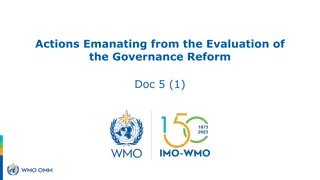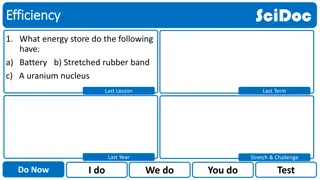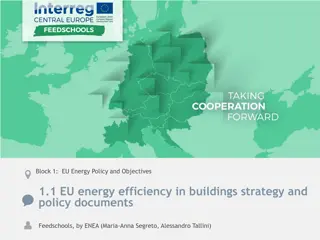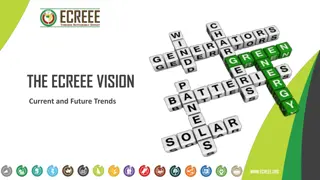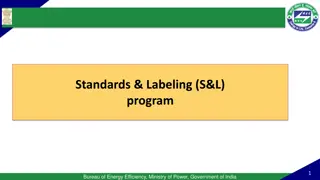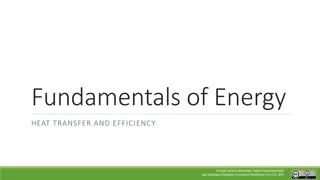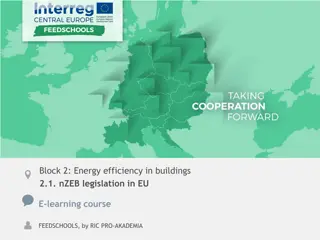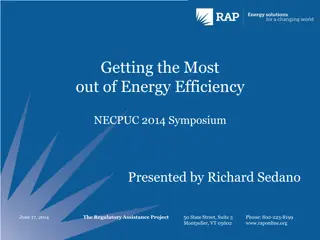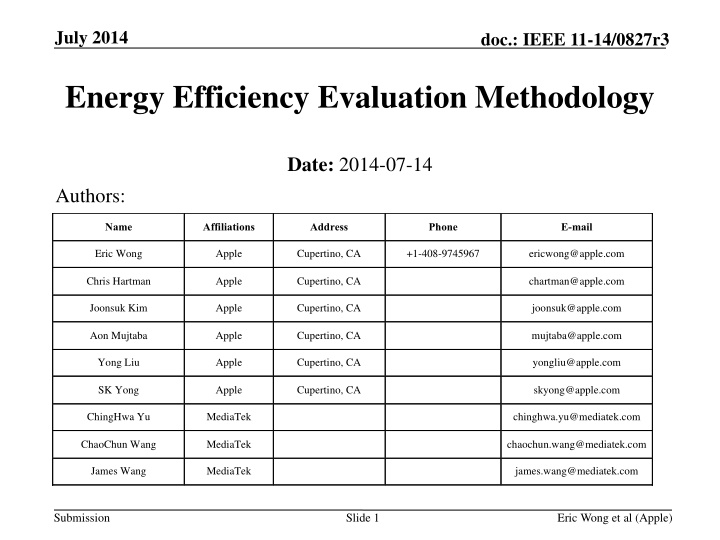
Energy Efficiency Evaluation Methodology in IEEE Document July 2014
Explore the Energy Efficiency Evaluation Methodology outlined in the IEEE document of July 2014, presented by authors from Apple, Nokia, Huawei, and Intel. The content covers proposed metrics, power models, states, transitions, and more related to energy efficiency in networking technologies.
Download Presentation

Please find below an Image/Link to download the presentation.
The content on the website is provided AS IS for your information and personal use only. It may not be sold, licensed, or shared on other websites without obtaining consent from the author. If you encounter any issues during the download, it is possible that the publisher has removed the file from their server.
You are allowed to download the files provided on this website for personal or commercial use, subject to the condition that they are used lawfully. All files are the property of their respective owners.
The content on the website is provided AS IS for your information and personal use only. It may not be sold, licensed, or shared on other websites without obtaining consent from the author.
E N D
Presentation Transcript
July 2014 doc.: IEEE 11-14/0827r3 Energy Efficiency Evaluation Methodology Date: 2014-07-14 Authors: Name Affiliations Address Phone E-mail Eric Wong Apple Cupertino, CA +1-408-9745967 ericwong@apple.com Chris Hartman Apple Cupertino, CA chartman@apple.com Joonsuk Kim Apple Cupertino, CA joonsuk@apple.com Aon Mujtaba Apple Cupertino, CA mujtaba@apple.com Yong Liu Apple Cupertino, CA yongliu@apple.com SK Yong Apple Cupertino, CA skyong@apple.com ChingHwa Yu MediaTek chinghwa.yu@mediatek.com ChaoChun Wang MediaTek chaochun.wang@mediatek.com James Wang MediaTek james.wang@mediatek.com Submission Slide 1 Eric Wong et al (Apple)
July 2014 doc.: IEEE 11-14/0827r3 Authors: Name Affiliations Address Phone E-mail Chittabrata Ghosh Nokia chittabrata.ghosh@nokia.com Sayantan Choudhury Nokia sayantan.choudhury@nokia.com Jarkko Kneckt Nokia jarkko.kneckt@nokia.com Phillip Barber Huawei pbarber@broadbandmobiletech.com Roy Luo Huawei roy.luoyi@huawei.com Robert Stacey Intel robert.j.stacey@intel.com Submission Slide 2 Eric Wong et al (Apple)
July 2014 doc.: IEEE 11-14/0827r3 Outline Proposed energy efficiency metrics Power model Power states and power state transitions 802.11 power save mechanisms Proposal for modifications to 802.11ax simulation scenarios Calibrating power models Setting the bar for energy efficiency Evaluating energy efficiency Conclusion Submission Slide 3 Eric Wong et al (Apple)
July 2014 doc.: IEEE 11-14/0827r3 Proposed Energy Efficiency Metrics Metric Units Definition Total energy consumed by a STA divided by the total number of successful data bits transmitted by the STA Per-STA energy per TX bit Joules/bit Total energy consumed by a STA divided by the total number of successful data bits received by the STA Per-STA energy per RX bit Joules/bit Submission Slide 4 Eric Wong et al (Apple)
July 2014 doc.: IEEE 11-14/0827r3 Power Model For evaluating of power efficiency, a power model is defined in this contribution with these 3 components: 1. Power states 2. Power state transitions 3. Power save mechanism Submission Slide 5 Eric Wong et al (Apple)
July 2014 doc.: IEEE 11-14/0827r3 Power States and Power Consumption Levels A STA operates in one of 5 power states when exchanging frames with other STAs, or sleeping to conserve power and prolong battery life The states are Transmit, Receive, Listen, Shallow Sleep and Deep Sleep Deep Sleep, compared to Shallow Sleep, is the state with the lowest consumption power; a STA takes a much longer time to transition into and out of Deep Sleep to Awake Power consumed in each power state depends on the number of spatial streams, channel bandwidth, transmit power, and frequency bands in Awake states (i.e. Transmit, Receive, Listen) Note MCS and coding schemes affects power consumption for Transmit and Receive states; however, we make the assumption that the effects from these two factors are negligible Clock inaccuracy means STA has to wake up early to catch the Beacon; however, this effect is assumed to be negligible E.g. STA with 100ppm, and waking up every 3 Beacon Intervals of 100 TUs would experience a clock drift of 30us A power table, enumerating power states and power consumption levels, is design and implementation dependent Nevertheless, a reference power table is needed for calibrating power models across System simulators and evaluating power save proposal(s) Submission Slide 6 Eric Wong et al (Apple)
July 2014 doc.: IEEE 11-14/0827r3 Example of Power States and Power Consumption Levels Average Power Consumption (mW) Bandwidth = 40 MHz, Band = 5 GHz TX power per antenna[4] = 18 dBm (STA), 15 dBm (P2P) Power State NSS 1 2 3 Transmit 1280 1990 2100 Receive 940 1270 1600 Listen 820 1130 1450 Shallow Sleep 100 100 100 Deep Sleep - - - Source: D. Halperin et al, Demystifying 802.11n Power Consumption, Proceedings of the 2010 International Conference on Power Aware Computing and System, 2010 Submission Slide 7 Eric Wong et al (Apple)
July 2014 doc.: IEEE 11-14/0827r3 Power State Transitions and Consumption Levels When a STA switches from one power state to another, there is a non-zero cost for this transition Cost is added latency, or extra power consumed The reference power state transition table is used for power model calibration across System simulators We make the assumption that these power state transitions are independent of MCS, channel bandwidth, frequency bands, etc. Refer to Slide 19 in Appendix for table for power state transition Transmit Receive Listen Shallow Sleep Deep Sleep Submission Slide 8 Eric Wong et al (Apple)
July 2014 doc.: IEEE 11-14/0827r3 802.11 Power Save Mechanisms Propose to adopt 3 existing power save mechanisms in 802.11-2012 as baseline for power efficiency evaluation Power save mode (PSM) Power save polling (PSP) Unscheduled automatic power save delivery (U-APSD) Submission Slide 9 Eric Wong et al (Apple)
July 2014 doc.: IEEE 11-14/0827r3 Example of Power States and Power State Transitions during Power Save Polling Operation AP buffers this frame since this STA is in Power Save Assuming there no other traffic in medium DATA Beacon ACK DATA Beacon AP STA PS-Poll ACK STA starts CCA for PS-Poll AP starts CCA for downlink DATA Assume DTIM=3 SS/DS LI RX RX TX DS SS LI TX LI RX LI STA Power State and State Transition RX TX SS LI TX LI RX TX SS Transmit (TX) Shallow Sleep (SS) Deep Sleep (DS) Receive (RX) Power State Transition Listen (LI) Submission Slide 10 Eric Wong et al (Apple)
July 2014 doc.: IEEE 11-14/0827r3 Proposal for Modifications to 802.11ax Simulation Scenarios Proposed Power Model Scenario Topology Traffic Model Type A - Multi-floor building, 5 floors (each floor is 3m high), 2x10 apartments per floor, apartment size 10m x 10m x 3m, M APs per floor, N STAs per apartment PSM Residential (1) Buffered video streaming Type B - Office floor, 8 offices, 64 cubicles per office, 4 STAs per cubicle (laptop, monitor, smartphone/tablet, harddisk) Local file transfer, lightly internet streaming video/audio, VoIP PSP, U-APSD Enterprise (2) Highly compressed video (streaming), web browsing, local file transfer, multicast video streaming Type C - BSSs in regular and symmetric grid with frequency reuse 3 or 7, AP in center and STAs randomly placed in hexagon, N (40) STAs per BSS Indoor Small BSS Hotspot (3) PSM, PSP Highly compressed video (streaming), web browsing, local file transfer Outdoor Large BSS Hotspot (4a) Type D - 19 hexagonal grid with inter cell distance at 130m, N (50) STAs per BSS PSM, PSP Type D + Type A - 7 hexagonal cells with inter cell distance (ICD) at 130m, one residential building per BSS with center placed in a random uniform position within a radius of ICD/2 around AP Outdoor Large BSS Hotspot + Residential (4b) PSM, PSP Type D + Type A Source: IEEE 802.11-14-0621r3 Submission Slide 11 Eric Wong et al (Apple)
July 2014 doc.: IEEE 11-14/0827r3 Calibrating Power Models Adopt power tables in slides 18-19 in System simulators Implement the baseline power save mechanisms, i.e. PSM, PSP, U-APSD Verify implementation of baseline power save mechanisms across System simulators For each simulation scenario, along with the power save mechanism, check that the throughput metric is comparable across System simulators Verify implementation of power efficiency metrics across System simulators For each simulation scenario, along with the traffic and power models, check that both throughput and power efficiency metrics are comparable across System simulators Submission Slide 12 Eric Wong et al (Apple)
July 2014 doc.: IEEE 11-14/0827r3 Setting the Bar for Energy Efficiency Propose Energy Efficiency Rating Defined as the ratio of energy consumed for one bit of data successfully exchanged between STAs using any new proposed power save mechanism over the baseline power save mechanism, i.e. New Energy Per Bit EER= Old Energy Per Bit Any new proposed mechanisms should meet the following 3 requirements 4 times average Per-STA throughput improvement [1] Transmission latency constraints requirements (TBD; see [3]) Maintain or reduce energy per successful information bit, i.e. energy efficiency rating of at least one or less Specifically, any proposed power save mechanism should have an energy efficiency rating less than one Submission Slide 13 Eric Wong et al (Apple)
July 2014 doc.: IEEE 11-14/0827r3 Evaluating Energy Efficiency Required metrics to evaluate power save mechanisms As already defined in the simulation scenario document [3] [4] Per-STA and/or Per-BSS throughput Packet loss Transmission latency In addition to the above, the following needs to be added Per-STA energy per TX bit Per-STA energy per RX bit Power save mechanisms proposed in 802.11ax should be benchmarked using the above mentioned metrics against: Other power save mechanisms proposed in 802.11ax Baseline power save mechanisms in the simulation scenarios (refer to slide 11) Submission Slide 14 Eric Wong et al (Apple)
July 2014 doc.: IEEE 11-14/0827r3 Conclusion This contribution proposes a systems approach (covering both PHY and MAC) to evaluate energy efficiency for 802.11ax; this is similar to how throughput performance is evaluated for previous 802.11 amendments Change the simulation scenario document [4] as follows: Add definitions for energy efficiency metrics in Slide 4 Add power tables in Slides 18-19 Adopt 3 baseline power save mechanisms, i.e. Power save mode (PSM) Power save polling (PSP) Unscheduled automatic power save delivery (U-APSD) Add power save mechanism to each simulation scenario (and associated traffic models) Incorporate proposed power model to the evaluation methodology document [3] Add definition for Energy Efficiency Rating Submission Slide 15 Eric Wong et al (Apple)
July 2014 doc.: IEEE 11-14/0827r3 References 1. 2. 3. 4. 5. http://www.ieee802.org/11/PARs/P802.11ax.pdf IEEE 802.11-2012 R. Porat et al, 11ax Evaluation Methodology, IEEE11-14-571r2 S. Merlin et al, TGax Simulation Scenarios, IEEE 11-14-621r4 G. Park et al, Discussion on power save mode for real time traffic, IEEE 11-14- 352r0 D. Halperin et al, Demystifying 802.11n Power Consumption, Proceedings of the 2010 International Conference on Power Aware Computing and System, 2010 6. Submission Slide 16 Eric Wong et al (Apple)
July 2014 doc.: IEEE 11-14/0827r3 Appendix Submission Slide 17 Eric Wong et al (Apple)
July 2014 doc.: IEEE 11-14/0827r3 Power States and Power Consumption Levels Average Power Consumption (mW) Power State Bandwidth = { 20 MHz, 40 MHz, 80 MHz, 160 MHz }, Band = { 2.4 GHz, 5 GHz } TX power per antenna [4] = 18 dBm (STA), 15 dBm (P2P) NSS 1 2 3 4 5 6 7 8 Transmit Receive Listen Shallow Sleep Deep Sleep Submission Slide 18 Eric Wong et al (Apple)
July 2014 doc.: IEEE 11-14/0827r3 Power State Transitions and Consumption Levels State Transitions Transition Time (ms) Average Power Consumption (mW) Transmit Listen (0 , 0) (0 , 0) Receive Listen (0 , 0) (0 , 0) TRT (e.g. SIFS of 16us) PRT Receive Transmit TTS PTS Transmit Shallow Sleep TRS PRS Receive Shallow Sleep Listen Shallow Sleep (TLS , TSL) (PLS , PSL) Deep Sleep Shallow Sleep (TDS , TSD) (PDS , PSD) Submission Slide 19 Eric Wong et al (Apple)


